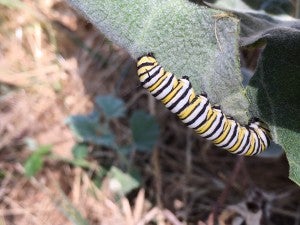
A monarch caterpillar eats showy milkweed at Davis Ranch in Colusa, California.
The western population of monarch butterflies is in steep decline, according to a recent study released by the Xerces Society, having fallen 74 percent in the past two decades, from roughly 1.2 million in 1997 to fewer than 300,000 butterflies in 2015.
Studies have documented the drop in eastern populations over the past several years, but this is the first time we’ve been able to understand the risks to the western population, which resides west of the Rocky Mountains.
The population is struggling because of development around the forested groves where they spend winters along the California coast and in Mexico, and because of pesticide applications that kill vital milkweed habitat. These threats and the population decline are significant, having the potential to influence a U.S. Fish and Wildlife Service decision in coming years if the situation fails to turn around soon.
I’ve feared for many years that the monarch might reach the point that it will require protections under the Endangered Species Act – a last resort that signals a dire state for the iconic and beloved species. But a recent trip to California gave me great hope that it’s not too late to change the monarch’s trajectory.
Farmers are the lifeline
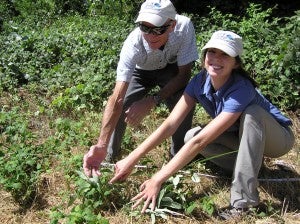
EDF’s David Wolfe and Audrey Archer find a monarch caterpillar while counting stems in a milkweed patch at Davis Ranch. They counted 337 stems total.
Davis Ranch is a sustainable farming operation spanning thousands of acres in Colusa, just an hour’s drive north of Sacramento. The ranch produces a variety of crops including rice, tomatoes, sunflowers and wheat to name a few. But it’s also producing a variety of conservation benefits for local wildlife and the local community.
“By implementing practices that save water, reduce waste, utilize natural fertilizers and cover crops as well as provide and protect natural habitats for our abundant wildlife, we can insure that farming will remain a way of life on our ranch for many years to come.” – The Davis Ranch Approach to Farming
John Brennan is the farm manager at Davis Ranch, where he helps the farm owners make decisions about how to manage the business to earn a profit and benefit the environment. John welcomed us to the property last week, allowing us to test a habitat quantification tool that we have been developing to better assess monarch habitat quality.
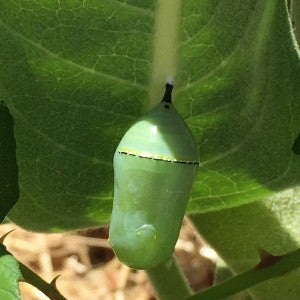
A chrysalis found at Davis Ranch. The chrysalis represents the third stage of the monarch life cycle, after the egg and larvae (caterpillar) stages, before becoming an adult butterfly.
I didn’t know what we’d find at the property, since I knew there was only one small patch of milkweed. I was pleasantly surprised to not only find some fairly high quality milkweed habitat, but also to see some monarch caterpillars, butterflies and even a monarch chrysalis. Carl Stenoien, a Ph.D. candidate at the University of Minnesota who works with Dr. Karen Oberhauser at the Monarch Lab, joined us for the field test and told me that he has only seen three chrysalids in his lifetime, so it was quite a treat to see one in person.
Since we saw various stages of the monarch life cycle – eggs, caterpillars at various growth stages, chrysalids and adult monarchs – all in one milkweed patch, we know that multiple monarchs visited this site at different times. Given the size of the ranch, it’s pretty impressive that so many monarchs were attracted to this tiny roadside patch. It’s a promising sign that the habitat on Davis Ranch is serving the species well, and that with a few additional conservation practices, such as avoiding mowing during times of high monarch activity or planting native flowering plants for nectar sources, this habitat could be enhanced to support even more monarch butterflies in the future.
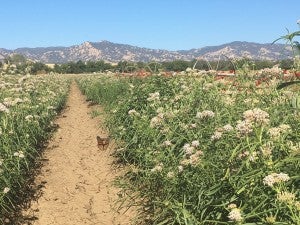
A monarch butterfly soars between rows of milkweed in a production field at Hedgerow Farms.
Where conservation and crop production meet
The end goal for the monarch habitat quantification tool is to be able to measure conservation outcomes so that incentive payments (from public or private investments) can be directed to landowners willing to protect, enhance or restore milkweed habitat on their property. We like to say that this will allow landowners to get paid for planting milkweed, just like they would with any other crop.
In the case of Hedgerow Farms, they are already doing just that.
John Anderson is the owner and founder of Hedgerow Farms, where he has been committed to growing milkweed and other native grasses, forbs, sedges and rushes to sell the seed and plants for various uses, particularly for restoration projects in the area.

EDF experts assess the quality of milkweed habitat within a transect in a garden at Hedgerow Farms.
Not only are the cultivated seeds helping other landowners plant milkweed for monarchs, but his production fields are a monarch haven. We saw dozens of adult butterflies flying above the rows of milkweed, stopping to feed on the flowers’ nectar. It was quite a sight.
We visited a few other parts of the property to test the habitat quantification tool, including a roadside and a small garden where milkweed had expanded outward from a few initial plantings, as opposed to the row crop formation. These sites proved to be just as robust as the production fields, with dozens, if not hundreds of monarch caterpillars feeding on the leaves.
With all of the high quality habitat available to monarchs at Hedgerow Farms, there is a huge opportunity to protect, enhance and even expand the habitat at this property to provide valuable breeding and nectaring habitat for butterflies for years to come.
Seeds of hope for the monarch’s future
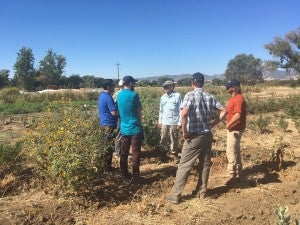
John Anderson, owner of Hedgerow Farms, addresses the field team at one of the milkweed sites before testing begins.
More than the sheer volume of milkweed or monarchs that I saw last week, I was most inspired by the landowners’ sincere stewardship values: they wanted to grow food and plants in a way that would be sustainable for generations to come.
Besides the milkweed production fields at Hedgerow Farms, all of the other milkweed we saw – in roadsides, field edges and gardens – was planted without any financial reward, for the sole benefit of providing habitat for monarchs and other pollinators. Of course there is also some intrinsic value to the landowners in that they can feel good about helping a species at risk, and enjoy the beauty and wonder of monarch butterflies.
The trip left me feeling very hopeful about the future for monarchs, knowing that farmers and ranchers are ready and willing to help. We just need to give them the tools and support.
Related:
How can we better target public funds for wildlife conservation? Look to Elliott Ranch >>
Monarch butterflies get help from Texas ranch >>
Monarchs still need milkweed, and farmers are growing it >>










10 Comments
I try to plant as many different varieties of milkweed to attract the butterflies all season. This year it has worked very well and I have been handraising butterflies since March. I have monarch I release and in a few days I have eggs again. I love the cycle
Thank you for helping to conserve monarch habitat! Xerces Society is a great resource for finding milkweed varieties that are native to your area (http://www.xerces.org/milkweed-seed-finder/), and University of Minnesota’s Monarch Lab has resources for raising healthy butterflies (http://monarchlab.org/biology-and-research/monarch-rearing/).
Most of my caterpillars hang from my wall or screen door and don’t make it.am I right that they have to hang free . Others have made it if they got to the roof. What about a small screen over the milkweed. I only planted two milkweeds but this experience has been fantastic.
This is really great news. Hope more farmers/ranchers can follow suit. We are raising Monarchs here in Southern California as fast as we can!
I am aware of only three patches of wild Narrow Leaf Milkweed in Sutter County. I watched a female Monarch laying eggs on the Pennington Rd patch Saturday. I have several kinds of Milkweed growing in my yard but no eggs so far this year.
Are we not supposed to just plant the species of milkweed that would be from our local habitat? I’m just responding to the comment from someone who said that they planted many kinds. I am curious.
All the emphasis on planting new milkweeds diverts attention away from saving the existing milkweeds. So even in. the Xerces Society’s home state of Oregon, roadside mowing is an ongoing problem https://youtu.be/nsvD6XWM8AA
So plant local milkweed species where you can be in control. I planted a few gallon pots of 2 local species a couple years ago and now there are about 15 milkweed plants in my garden. About a month ago there were 60 caterpillars on those few plants. I transferred about half of them to a nearby restoration site where milkweed was planted and there is an abundance of caterpillar food but not very many caterpillars. I’ve been checking back and this is not absolutely scientific, but it appears that the transferees did fine there. The “local” caterpillars are also doing well. There were freshly minted adult monarchs flitting about there and here too in my garden. I feel like I’m almost on a first name basis with the ones in my backyard. I didn’t expect the ones reared here to stick around, but some of them have and just today were laying more eggs on the milkweed. Which I’ve been watering and keeping as aphid and insect predator free as possible for the next generation. It’s fun and it all starts with planting milkweed.
The european scientists Know what is killing off the bees and the butterflys. They had the same problem. The solution for them was simple, ban Roundup and all its sister brands and they start coming back almost immediately. Have you seen the film where they used round up on half a field of sunflowers?(none on the other) THe bees would lite to collect pollen on the round-up half, and would soon start wandering around as if the didn’t know what they were doing. Soon they would fall to the ground and die. On the other half,normal activity. Watch the film. Why don’t we hear about this? Bayer and other chemical companies contribute heavily to the reelection fund of many politicians in the US of A.
Number one killer of wildlife is drought. The one in CA has been going on for years putting native milkweed, the monarch host plant they lay eggs on, and flowers they feed on when in flight into almost complete dormancy on the landscape. This milkweed is not dead. It exist below the surface and is kept alive by its “taproot” that extends many feet into the ground. These taproots have existed on the same plants for decades and brought the milkweeds and therefore the monarch through these dry hot times before. When normal rains return the plants will put on surface roots stems and leaves and the remnant monarch population will expand as it has on the Eastern monarch range the last three seasons after the 2009-13 drought. Unless milkweed that is planted now has a supplemental water source to keep it above the ground it’s useless to attempt to establish new plants. Weed scientist as myself across the country know this although they wish to create a fear monarchs will disappear completely if humans don’t due something about it. The solution should be to promote the production and sale of milkweed by commercial growers so the general public can plant them in their yards and establish them to help keep this remnant monarch population until normal rains return not spend millions of taxpayer $$$ paying ngo’s directors to promote landscape scale milkweed planting that won’t survive the drought anyway because of insufficient time to establish its lifesaving taproot. Ask growers to grow pesticide free milkweed and native plants to sell to garden centers and help promote this market approach to help the pollinators and save tax dollars you don’t have ;)